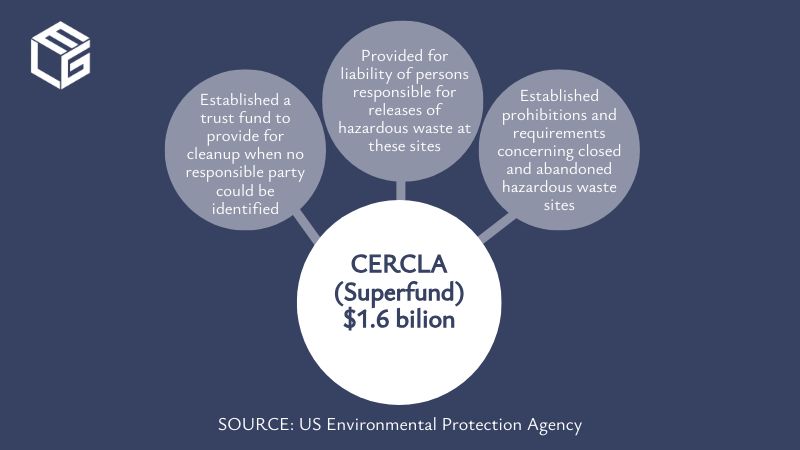The new EPA rule designates PFOA and PFOS as hazardous substances under CERCLA
EPA's final rule from April 19, 2024, designated two PFAS legacy contaminants as hazardous substances under CERCLA Section 102. The rule nominates perfluorooctanoic acid (PFOA) and perfluorooctanesulfonic acid (PFOS) as dangerous substances, including their salts and structural isomers. Due to this new EPA listing, sites contaminated with PFOS an PFOA become subject to response actions such as reporting, investigation, remediation, and monitoring conducted under the auspices of CERCLA.
EPA's designation of PFOS and PFOA under CERCLA may result in additional remedial liability for Superfund sites throughout the country and potentially create new sites. The rulemaking makes a broad range of industrial and governmental entities potentially liable for Superfund cleanup for releases of PFOA and PFOS, including:
- manufacturers or importers
- processors
- manufacturers of products containing PFOS and PFAS
- downstream product manufacturers and users of PFAS products
- waste management and wastewater treatment facilities
By defining PFAS (PFOS, PFOA) contaminants as “hazardous substances,” the EPA can now compel cleanup by responsible parties.
It is the first time any chemical has been designated as a hazardous substance by regulation, and it enables EPA to utilize a much broader array of CERCLA tools, including addressing releases without demonstrating an imminent and substantial danger, to seek expense recovery and to urge potentially responsible parties to pay for response work. Where a response action was taken by a third party having a contractual relationship with the claimant, payment of the claim will be adjusted accordingly. Potentially responsible parties may include current and former site owners, operators, certain hazardous substances generators, and transporters. Additionally, these entities must report to the National Response Center any PFOA or PFOS release that meets or exceeds the quantity of one pound within a 24-hour.
Under the new rule, agencies or other parties conducting CERCLA response actions addressing PFOS and PFOA contamination can seek cleanup cost recovery from potentially responsible parties.
In tandem with the final rule, the EPA released a PFAS Enforcement Discretion and Settlement Policy that describes the EPA’s enforcement priorities for PFAS and indicates exercising discretion in bringing CERCLA actions against specific categories of potential potentially responsible parties, including:
- public water systems
- publicly owned treatment works
- publicly owned or operated municipal solid waste landfills
- publicly owned airports and local fire departments
The EPA’s enforcement discretion policy indicates that it is shifting focus on enforcing the new rule on entities that have manufactured PFAS and released significant amounts of PFOA or PFOS into the environment. However, all parties should be aware that this policy is not self-implementing. Even if a party is in a presumptive enforcement discretion category, it must prove eligibility under the factors. It’s also worth noting that the EPA offers no protection against Natural Resource Damage Claims.
Unfairly, the costs of CERCLA cleanup have mostly been paid by the parties whose properties were contaminated
In 1978, a state of emergency was declared in Love Canal, New York. Hundreds of people within the Niagara Falls neighborhood were struggling with serious health problems, ranging from skin conditions to leukemia. The cause of their suffering was living in close proximity to a hazardous landfill.
As a consequence of this unfortunate occurrence, the federal government passed CERCLA. This act gives the federal government the power to tax chemical and petroleum companies liable for releasing hazardous waste into unregulated areas. Furthermore, the law enables federal authorities to directly respond to the dumping or spilling of dangerous substances that threaten the environment or human life.
The main purpose of CERCLA is to fund the costs entailed by the cleanup activities required to remove hazardous substances from contaminated sites. However, the expenses of cleanup procedures are often very high, particularly if the contaminated region is extended and if the pollutants, which need to be abated are difficult to remove, as well as when the completion of the cleanup activities implies a long period of time. For this reason, we strongly encourage you to reach out to a lawyer whose primary area of practice is toxic exposure, who will help you recover the money necessary to pay for the cleanup of the contaminated area from the liable party.
The parties responsible for contamination may be any generators of hazardous materials on location, transporters of hazardous materials to the site, and past or present site owners. When no responsible party can be identified, the Environmental Protection Agency initiates the cleanup process of the contaminated area with the use of the money set aside for this purpose. However, when a responsible party can be identified, it can willingly cleanup the site, but if they are unwilling, the agency will order them to do it.
The Superfund of CERCLA currently has over $8.5 billion set aside for the cleanup of contaminated sites throughout the country. Furthermore, the purpose of this act was to:
- determine prohibitions and requirements concerning abandoned hazardous waste sites
- provide for liability of persons responsible for releases of hazardous waste at these sites
- establish a trust fund to provide for cleanup when no responsible party could be identified
In June 2024, there were 1,340 Superfund sites in the United States. The state with the largest number of Superfund sites was New Jersey, followed by California and Pennsylvania. On the other hand, the states with the least Superfund sites were North Dakota, which has no contaminated areas, Nevada and South Dakota. The largest Superfund site in the country is undoubtedly Hanford, which is located in Washington. It is a decommissioned nuclear production complex that was operated by the United States federal government on the Columbia River in Benton County.
